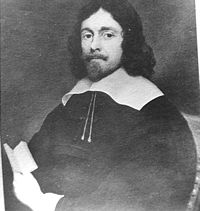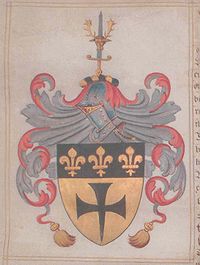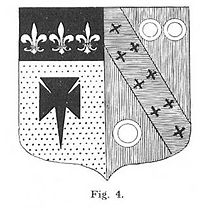
Sir William Brockman
Encyclopedia

Cavalier
Cavalier was the name used by Parliamentarians for a Royalist supporter of King Charles I and son Charles II during the English Civil War, the Interregnum, and the Restoration...
cause in the English Civil War
English Civil War
The English Civil War was a series of armed conflicts and political machinations between Parliamentarians and Royalists...
.
Early life
Sir William was born in 1595 in KentKent
Kent is a county in southeast England, and is one of the home counties. It borders East Sussex, Surrey and Greater London and has a defined boundary with Essex in the middle of the Thames Estuary. The ceremonial county boundaries of Kent include the shire county of Kent and the unitary borough of...
, England
England
England is a country that is part of the United Kingdom. It shares land borders with Scotland to the north and Wales to the west; the Irish Sea is to the north west, the Celtic Sea to the south west, with the North Sea to the east and the English Channel to the south separating it from continental...
, at Lyminge. His parents were Henry Brockman and Helen Sawking. Henry, the father has a tablet at St Nicholas Church, Newington. William earned a degree at Oxford University. He was knighted by Charles I
Charles I of England
Charles I was King of England, King of Scotland, and King of Ireland from 27 March 1625 until his execution in 1649. Charles engaged in a struggle for power with the Parliament of England, attempting to obtain royal revenue whilst Parliament sought to curb his Royal prerogative which Charles...
in 1632.
Defence of the Town of Maidstone Against Fairfax
Sir William Brockman was a royalist adherent of King Charles ICharles I of England
Charles I was King of England, King of Scotland, and King of Ireland from 27 March 1625 until his execution in 1649. Charles engaged in a struggle for power with the Parliament of England, attempting to obtain royal revenue whilst Parliament sought to curb his Royal prerogative which Charles...
. Sir William was appointed High Sheriff of Kent
High Sheriff of Kent
The High Sheriff is the oldest secular office under the Crown. Formerly the High Sheriff was the principal law enforcement officer in the county but over the centuries most of the responsibilities associated with the post have been transferred elsewhere or are now defunct, so that its functions...
by the King in 1642, but was almost immediately arrested and imprisoned in Winchester House, Southwark, London in a move that seems to have sought to remove potentially influential Royalist supporters from the scene. He was replaced as Sheriff by Sir John Honeywood. William remained under in prison until August 1645, although after a time he was transferred from London back to Westenhanger house in Kent; only a couple of miles from his home at Beachborough.
In the second civil war period that flared up in 1648, William did indeed become directly involved in fighting for the first and only time, under the command of Sir John Mayney. Separated from the main loyalist forces, the detachment in Maidstone had to fight against Farifax's trained army unsupported.
Fairfax's elite division marched on Maidstone, which was at the time garrisoned by ~1,000 royalist horse and foot. General Fairfax passed the river at Farleigh Bridge and attacked the town with a corps of ~10,000 men. The assault began at about seven o'clock in the evening. The fighting intensified and spread into every street, which, with the houses, were lined by the royalists, whose strength had been augmented by Sir William, who had brought in a reinforcement of 800 men during the preliminary skirmishing. The resistance of the townsmen was determined, and Fairfax had to literally contend for every inch of the ground; and the conflict endured to midnight. Around midnight, the outnumbered royalists were driven into a churchyard where they took shelter and continued to resist with unabated vigour. They were eventually forced to surrender upon conditions securing their personal safety. Fairfax's report to Parliament of confirms that Sir William and the other leaders were arrested. Records show that William was still a prisoner in 1651, when he, his brother Zouch and many other royalists were declared delinquents and had heavy fines levied against them. Sir William was fined £500 and Zouch £350. It is remains uncertain as to when William was released on this second occasion, but it is notable that he did not lose his estate and was able to pass it on to his son after his death in 1654.
In somewhat flowery prose the 1836 edition of Burke's Commoners closes: "Few actions displayed more of that chivalric courage and devoted resolve which characterised the adherents of the King during the civil wars than this. Lord Clarendon terms it a sharp encounter very bravely fought with the general's whole strength".
Letter Regarding Battle at Maidstone by Fairfax



Family life
The Brockman familyBrockman
The Brockman surname is not common, but has spread to several countries around the world. The name can be a topism combining "wet/water" and "man". However, in Old English and in heraldry a "brock" is also a badger, and some have claimed it to mean "broker". Thus, there may be multiple meanings of...
has a long history in Kent and had a number of properties in Kent at that time. William's great grandfather Henry Brockman bought Newington Manor, Cheriton Manor and Beachborough Manor
Beachborough Manor
Beachborough Manor was a manor in Beachborough, Kent, UK purchased by Sir William's great-grandfather Father Henry Brockman ca. 1500 and subsequently passed through various squires in the English Brockman family. Like many buildings in the UK, it found use in World War II by the Allies, as an...
. Sir William married Anne, only daughter and heiress of Simon Bunce, Esqre., of Linstead and had issue one son, James, his heir, and four daughters. As one of very few notable and documented Kentish Englishmen from his era, Sir William is of some interest to descendants of his relatives that now live in the US and Australia today. For example, it appears that in the aftermath of the civil war his second cousin, Henry Brockman fled the country to Aruba and eventually to the American colonies, thus founding the English branch of the Brockman family
Brockman
The Brockman surname is not common, but has spread to several countries around the world. The name can be a topism combining "wet/water" and "man". However, in Old English and in heraldry a "brock" is also a badger, and some have claimed it to mean "broker". Thus, there may be multiple meanings of...
in the United States. Later, descendants through the maternal Drake-Brockman line emigrated to Australia, several of whom were notable for their military and civic leadership.
Sir William died on and was buried on 6 December 1654. James the second son, inherited the estate as the first son died in infancy.
Further reading
County histories (An earlier edition Reprinted and sold by Meggy and Chalk, 1816)Family histories (Out of Print), this information provided courtesy of Paul Brockman (Virginia) (Out of Print), provided courtesy of Hugh-Drake Brockman (UK),
Primary sources
- The Brockman Papers, Records in the British Museum, Location and Catalogue: 42586-42710, 45193-45220
External links
For further information on the Brockman & Drake-Brockman family see http://www.brockman.net.au

